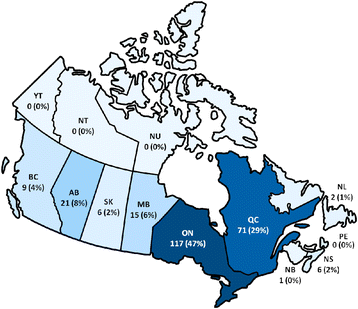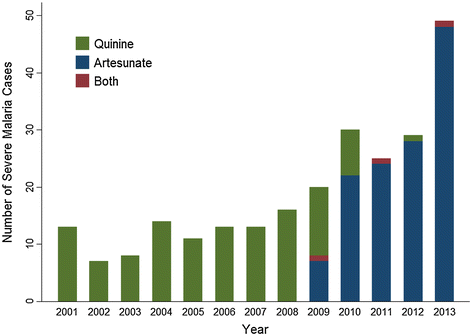Severe malaria in Canada, 2001-2013
- PMID: 25890126
- PMCID: PMC4418046
- DOI: 10.1186/s12936-015-0638-y
Severe malaria in Canada, 2001-2013
Abstract
Background: Imported malaria is the principal, preventable, life-threatening infection among Canadians travelling abroad. The Canadian Malaria Network supplies information and parenteral malaria therapy to healthcare providers treating severe and complicated malaria and gathers surveillance information on these cases.
Methods: Data were collected on the characteristics, risk factors, and clinical outcomes of severe malaria cases in Canada from June 2001 to December 2013.
Results: The need for parenteral therapy in Canada has increased in the last decade. The vast majority of cases are reported from Ontario and Quebec and occur among travellers to and from Africa. Regardless of country of birth, all persons originating from endemic and non-endemic countries are at a similar risk of malaria-related complications. Overall use and appropriateness of pre-travel advice and chemoprophylaxis remains low. Most cases result from patient delays in recognizing symptoms and seeking appropriate medical attention. Although some healthcare delays occurred in a select number of cases, the majority of patients were diagnosed quickly and were appropriately treated with parenteral therapy within a few hours of diagnosis.
Conclusions: Data from the Canadian Malaria Network provide insight into the characteristics of imported severe and complicated malaria infections in Canada. Improved understanding of this population can help target risk reduction strategies and interventions to limit personal susceptibility and healthcare treatment delays.
Figures



References
-
- Geduld J, Bryson M, Straight-Caron T. 12th Conference of the International Society of Travel Medicine. Boston, Massachusetts, USA: Public Health Agency of Canada, Infectious Disease Prevention and Control Branch; 2011. Canadian trends of international travel and risk of malaria exposure.
-
- Reported malaria cases from 1924 to 2011 in Canada. [http://dsol-smed.phac-aspc.gc.ca/dsol-smed/ndis/charts.php?c=pl]
Publication types
MeSH terms
Substances
LinkOut - more resources
Full Text Sources
Other Literature Sources
Medical

